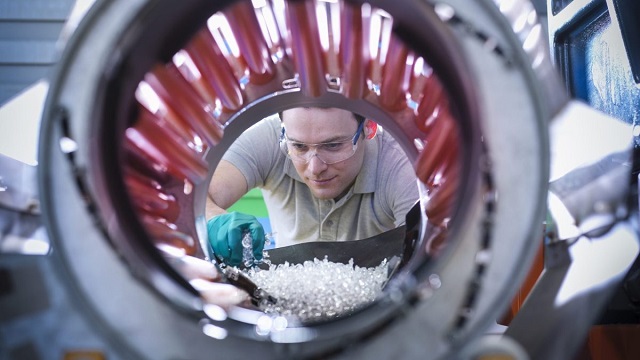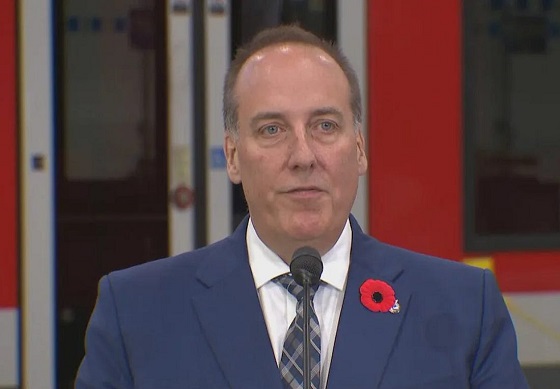Alberta
How natural gas supports one of Canada’s largest manufacturing sectors

Worker inspecting parts from plastic injection moulding machine in plastics factory. Getty Images photo
From the Canadian Energy Centre
‘When you think about the demand for more sustainable outcomes: clean air, clean water, clean energy, safe, nutritious, abundant food and electric vehicles, that’s more and more and more chemistry’
Canada’s chemical industry sold a record $72.7 billion of product last year amid recovery from COVID-19 and strong consumer demand, according to the Chemistry Industry Association of Canada (CIAC).
Natural gas is a key input to the chemistry sector, the broad term that refers to manufacturing a myriad of products used in everyday items from plastics to agriculture and pharmaceuticals.
“Chemistry products go into 95 per cent of finished goods. It’s an important sector,” says CIAC president Bob Masterson.
“It’s a sector that can grow as long as we fancy improving our lives and building a better world for tomorrow.”
Chemicals in Canada
Canada’s chemistry industry is the country’s fourth largest manufacturing sector by value of sales after food ($147 billion), transportation equipment ($119 billion), and petroleum/coal products ($118 billion).
It is primarily centered in Ontario, Alberta and Quebec.
The CIAC publishes an annual report on the sector’s activity using Statistics Canada data, separated into two categories: chemicals overall, and industrial chemicals.
Chemicals overall includes manufacturing of soaps, cleaning compounds, paints, coatings and adhesives, pesticides and fertilizers, pharmaceuticals, rubbers and synthetic fibres, and basic chemicals.
Industrial chemicals refers to the manufacturing of intermediate products used as inputs by industries including plastic and rubber products, forest products, transportation equipment, clothing, perfume and cosmetics, construction and pharmaceuticals.
Global Growth
According to Vantage Market Research, the global chemical market was valued at US$584 billion in 2022. It’s expected to grow by more than 55 per cent in the coming years to reach US$917 billion by 2030.
This isn’t just driven population growth, Masterson says.
“When you think about the demand for more sustainable outcomes: clean air, clean water, clean energy, safe, nutritious, abundant food and electric vehicles, that’s more and more and more chemistry,” he says.
“Some of the predictions are that the volumes of chemistry will double in the next 20 years. Canada and Alberta in particular are exceptionally well positioned to help meet future market demand for these products. The demand is not going away. There’s no question about that.”
Jobs
In 2022, Canada’s chemicals sector directly employed 90,800 people, or approximately the population size of Sudbury, Ontario. The industry paid about $7 billion in salary and wages.
That’s the direct impact of employment in the chemistry sector, but the CIAC estimates the full benefit to Canadians to be much higher as a result of indirect economic activity it supports.
CIAC estimates that every job in Canada’s chemistry sector creates another five indirect jobs in other parts of the economy. This means the sector supported 454,000 jobs across Canada in 2022.
Industrial chemicals alone directly employed 17,100 people and indirectly supported 85,600 jobs in the broader Canadian economy last year, the CIAC says.
Rising Trade
At a value of $72.7 billion, Canada’s overall chemical industry sales were their highest ever in 2022 – a 30 per cent increase compared to 2019, prior to the COVID-19 pandemic.
Industrial chemicals sales reached a record $34.2 billion, a 32 per cent increase compared to 2019.
Exports also increased last year, rising to a value of $52.8 billion compared to $45.9 billion in 2021. Of that, the sector exported $24.8 billion of industrial chemicals, up from $22.5 billion the previous year.
The United States is Canada’s main customer for chemical exports, representing 76 per cent of exports or $40.1 billion in 2022. The next largest export markets are China ($1.86 billion), the Netherlands ($1.7 billion), and the United Kingdom ($1.1 billion).
The Canada Advantage
Canada has distinct advantages as a chemical manufacturer and exporter including growing access to global markets, CIAC says.
In Alberta, the main advantage is access to low-cost natural gas resources – specifically valuable natural gas liquids like ethane, propane and butane.
“The rich abundance of natural gas liquids that come out of the ground when we drill for natural gas let Alberta be a low-cost chemistry producer despite being pretty much the only large chemistry industry worldwide that’s not on tidewater,” Masterson says.
Responsible Care
Since 1985, Canada’s chemistry industry has operated under an initiative called Responsible Care that encourages companies to innovate for safer and greener products.
CIAC reports that Responsible Care is now practiced in 73 countries and by 96 of the 100 largest chemical producers in the world.
Since 2005, CIAC members have reduced CO2 equivalent emissions by 13 per cent; reduced sulphur dioxide emissions by 94 per cent, and virtually eliminated large scale safety incidents. Since 2012, CIAC members have also reduced net water consumption by 13 per cent.
“We’re not standing in place,” Masterson says.
Alberta
‘Weird and wonderful’ wells are boosting oil production in Alberta and Saskatchewan

From the Canadian Energy Centre
Multilateral designs lift more energy with a smaller environmental footprint
A “weird and wonderful” drilling innovation in Alberta is helping producers tap more oil and gas at lower cost and with less environmental impact.
With names like fishbone, fan, comb-over and stingray, “multilateral” wells turn a single wellbore from the surface into multiple horizontal legs underground.
“They do look spectacular, and they are making quite a bit of money for small companies, so there’s a lot of interest from investors,” said Calin Dragoie, vice-president of geoscience with Calgary-based Chinook Consulting Services.
Dragoie, who has extensively studied the use of multilateral wells, said the technology takes horizontal drilling — which itself revolutionized oil and gas production — to the next level.
“It’s something that was not invented in Canada, but was perfected here. And it’s something that I think in the next few years will be exported as a technology to other parts of the world,” he said.
Dragoie’s research found that in 2015 less than 10 per cent of metres drilled in Western Canada came from multilateral wells. By last year, that share had climbed to nearly 60 per cent.
Royalty incentives in Alberta have accelerated the trend, and Saskatchewan has introduced similar policy.
Multilaterals first emerged alongside horizontal drilling in the late 1990s and early 2000s, Dragoie said. But today’s multilaterals are longer, more complex and more productive.
The main play is in Alberta’s Marten Hills region, where producers are using multilaterals to produce shallow heavy oil.
Today’s average multilateral has about 7.5 horizontal legs from a single surface location, up from four or six just a few years ago, Dragoie said.
One record-setting well in Alberta drilled by Tamarack Valley Energy in 2023 features 11 legs stretching two miles each, for a total subsurface reach of 33 kilometres — the longest well in Canada.
By accessing large volumes of oil and gas from a single surface pad, multilaterals reduce land impact by a factor of five to ten compared to conventional wells, he said.
The designs save money by skipping casing strings and cement in each leg, and production is amplified as a result of increased reservoir contact.
Here are examples of multilateral well design. Images courtesy Chinook Consulting Services.
Parallel
Fishbone
Fan
Waffle
Stingray
Frankenwells
Alberta
Alberta to protect three pro-family laws by invoking notwithstanding clause

From LifeSiteNews
Premier Danielle Smith said her government will use a constitutional tool to defend a ban on transgender surgery for minors and stopping men from competing in women’s sports.
Alberta Premier Danielle Smith said her government will use a rare constitutional tool, the notwithstanding clause, to ensure three bills passed this year — a ban on transgender surgery for minors, stopping men from competing in women’s sports, and protecting kids from extreme aspects of the LGBT agenda — stand and remain law after legal attacks from extremist activists.
Smith’s United Conservative Party (UCP) government stated that it will utilize a new law, Bill 9, to ensure that laws passed last year remain in effect.
“Children deserve the opportunity to grow into adulthood before making life-altering decisions about their gender and fertility,” Smith said in a press release sent to LifeSiteNews and other media outlets yesterday.
“By invoking the notwithstanding clause, we’re ensuring that laws safeguarding children’s health, education and safety cannot be undone – and that parents are fully involved in the major decisions affecting their children’s lives. That is what Albertans expect, and that is what this government will unapologetically defend.”
Alberta Justice Minister and Attorney General Mickey Amery said that the laws passed last year are what Albertans voted for in the last election.
“These laws reflect an overwhelming majority of Albertans, and it is our responsibility to ensure that they will not be overturned or further delayed by activists in the courts,” he noted.
“The notwithstanding clause reinforces democratic accountability by keeping decisions in the hands of those elected by Albertans. By invoking it, we are providing certainty that these protections will remain in place and that families can move forward with clarity and confidence.”
The Smith government said the notwithstanding clause will apply to the following pieces of legislation:
-
Bill 26, the Health Statutes Amendment Act, 2024, prohibits both gender reassignment surgery for children under 18 and the provision of puberty blockers and hormone treatments for the purpose of gender reassignment to children under 16.
-
Bill 27, the Education Amendment Act, 2024, requires schools to obtain parental consent when a student under 16 years of age wishes to change his or her name or pronouns for reasons related to the student’s gender identity, and requires parental opt-in consent to teaching on gender identity, sexual orientation or human sexuality.
-
Bill 29, the Fairness and Safety in Sport Act, requires the governing bodies of amateur competitive sports in Alberta to implement policies that limit participation in women’s and girls’ sports to those who were born female.”
Bill 26 was passed in December of 2024, and it amends the Health Act to “prohibit regulated health professionals from performing sex reassignment surgeries on minors.”
As reported by LifeSiteNews, pro-LGBT activist groups, with the support of Alberta’s opposition New Democratic Party (NDP), have tried to stop the bill via lawsuits. It prompted the Smith government to appeal a court injunction earlier this year blocking the province’s ban on transgender surgeries and drugs for gender-confused minors.
Last year, Smith’s government also passed Bill 27, a law banning schools from hiding a child’s pronoun changes at school that will help protect kids from the extreme aspects of the LGBT agenda.
Bill 27 will also empower the education minister to, in effect, stop the spread of extreme forms of pro-LGBT ideology or anything else to be allowed to be taught in schools via third parties.
Bill 29, which became law last December, bans gender-confused men from competing in women’s sports, the first legislation of its kind in Canada. The law applies to all school boards, universities, and provincial sports organizations.
Alberta’s notwithstanding clause is like all other provinces’ clauses and was a condition Alberta agreed to before it signed onto the nation’s 1982 constitution.
It is meant as a check to balance power between the court system and the government elected by the people. Once it is used, as passed in the legislature, a court cannot rule that the “legislation which the notwithstanding clause applies to be struck down based on the Charter of Rights and Freedoms, the Alberta Bill of Rights, or the Alberta Human Rights Act,” the Alberta government noted.
While Smith has done well on some points, she has still been relatively soft on social issues of importance to conservatives , such as abortion, and has publicly expressed pro-LGBT views, telling Jordan Peterson earlier this year that conservatives must embrace homosexual “couples” as “nuclear families.”
-

 Crime2 days ago
Crime2 days ago‘Modern-Day Escobar’: U.S. Says Former Canadian Olympian Ran Cocaine Pipeline with Cartel Protection and a Corrupt Toronto Lawyer
-

 National15 hours ago
National15 hours agoPsyop-Style Campaign That Delivered Mark Carney’s Win May Extend Into Floor-Crossing Gambits and Shape China–Canada–US–Mexico Relations
-

 Bruce Dowbiggin13 hours ago
Bruce Dowbiggin13 hours agoBurying Poilievre Is Job One In Carney’s Ottawa
-

 COVID-1912 hours ago
COVID-1912 hours agoCovid Cover-Ups: Excess Deaths, Vaccine Harms, and Coordinated Censorship
-

 Alberta1 day ago
Alberta1 day ago‘Weird and wonderful’ wells are boosting oil production in Alberta and Saskatchewan
-

 Alberta2 days ago
Alberta2 days agoAlberta on right path to better health care
-

 Artificial Intelligence1 day ago
Artificial Intelligence1 day agoLawsuit Claims Google Secretly Used Gemini AI to Scan Private Gmail and Chat Data
-

 Alberta1 day ago
Alberta1 day agoAlberta to protect three pro-family laws by invoking notwithstanding clause










